MIT170394 BN201: Professional Issues in IT Analysis
VerifiedAdded on 2020/03/01
|6
|1417
|147
Homework Assignment
AI Summary
This assignment addresses key issues in IT professionalism, including ethical dilemmas, time management, and persuasive communication. The student analyzes a scenario involving employee conduct in a usability test, referencing the ACS Code of Professional Conduct. The assignment also examines effective persuasion techniques, linguistic devices used in speeches, and the impact of procrastination. A reflective report details the student's personal experiences with time management, outlining challenges, evaluations, and plans for improvement. The report incorporates references to relevant books, journal articles, and e-journal articles to support the analysis.
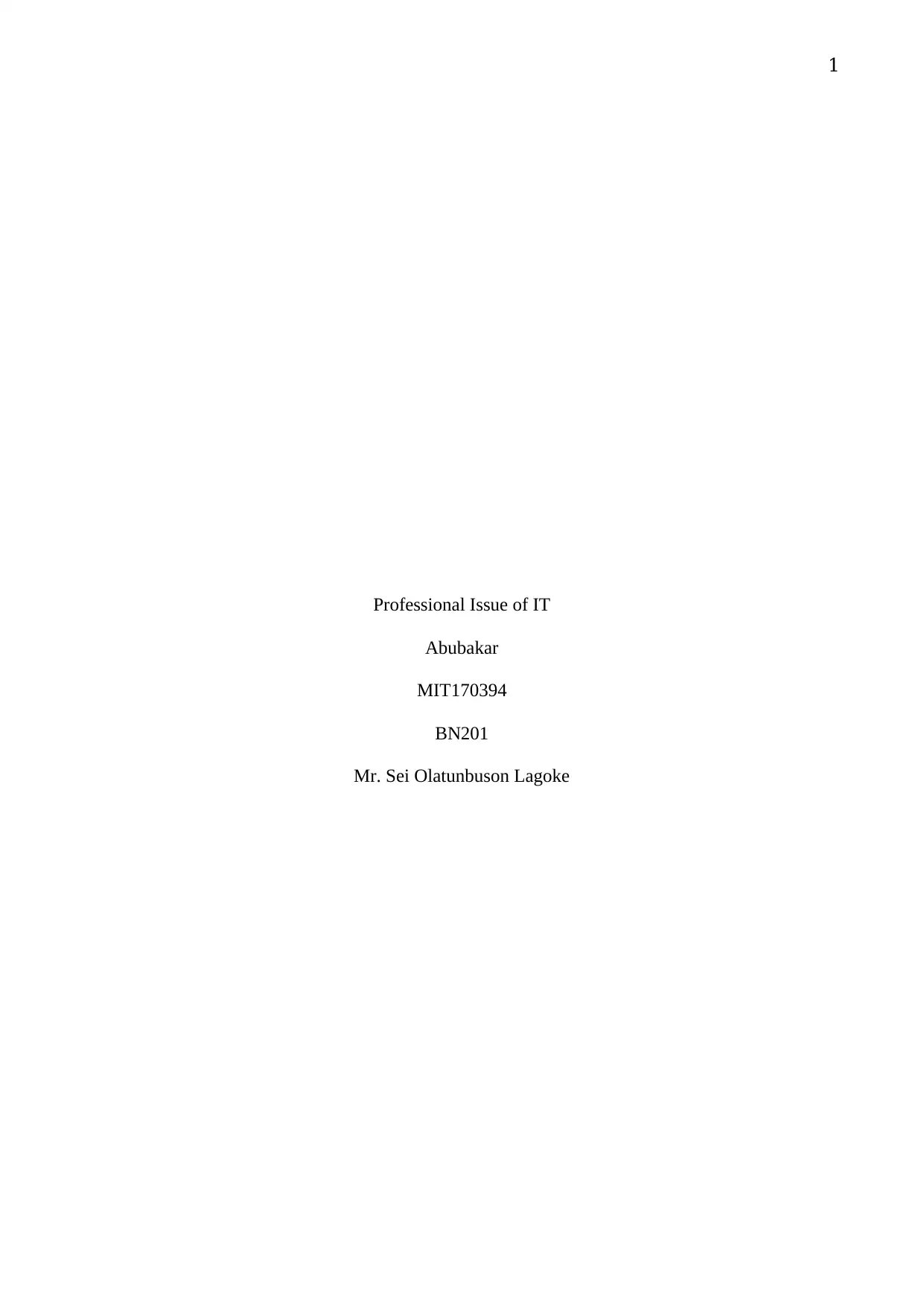
1
Professional Issue of IT
Abubakar
MIT170394
BN201
Mr. Sei Olatunbuson Lagoke
Professional Issue of IT
Abubakar
MIT170394
BN201
Mr. Sei Olatunbuson Lagoke
Paraphrase This Document
Need a fresh take? Get an instant paraphrase of this document with our AI Paraphraser
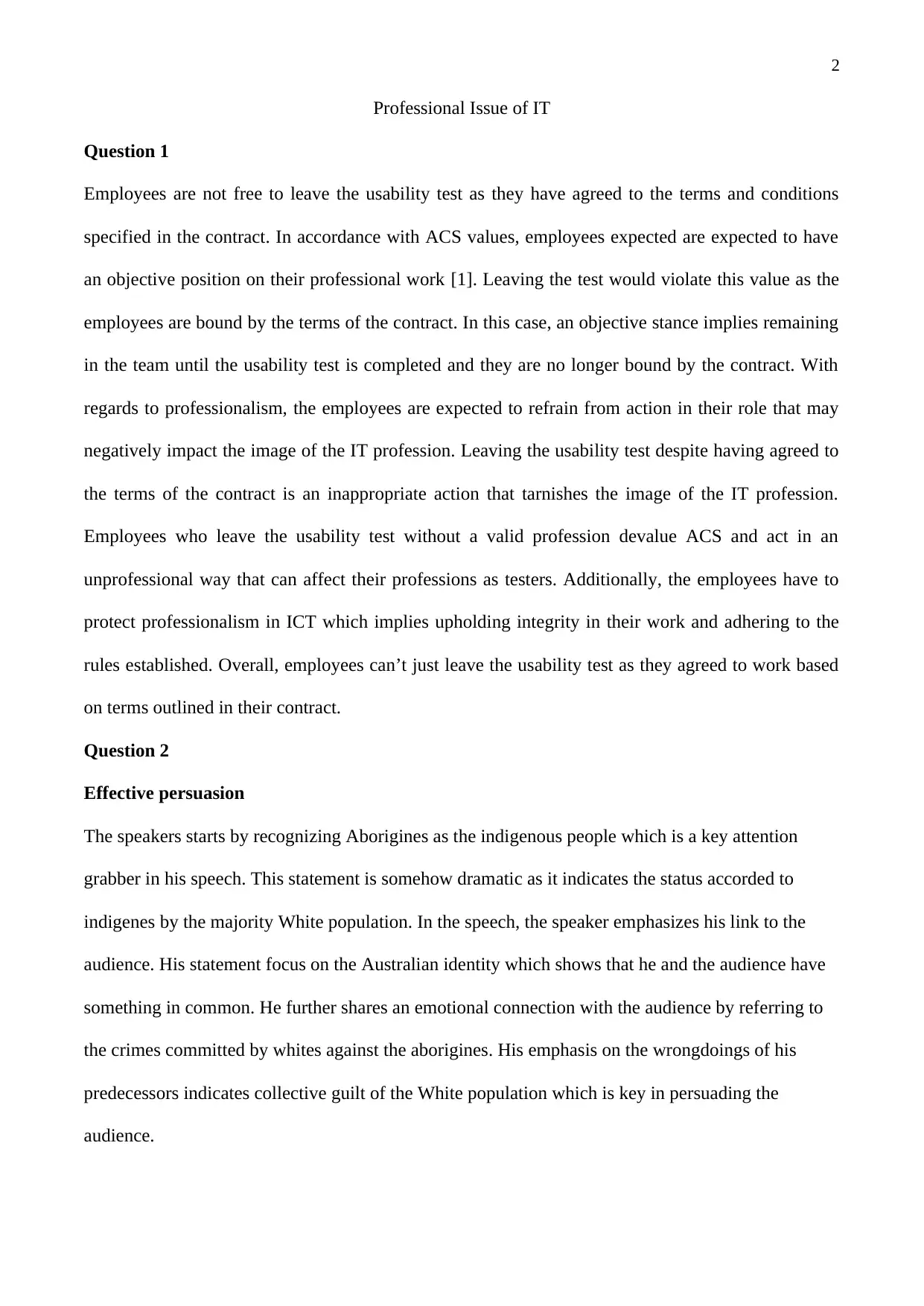
2
Professional Issue of IT
Question 1
Employees are not free to leave the usability test as they have agreed to the terms and conditions
specified in the contract. In accordance with ACS values, employees expected are expected to have
an objective position on their professional work [1]. Leaving the test would violate this value as the
employees are bound by the terms of the contract. In this case, an objective stance implies remaining
in the team until the usability test is completed and they are no longer bound by the contract. With
regards to professionalism, the employees are expected to refrain from action in their role that may
negatively impact the image of the IT profession. Leaving the usability test despite having agreed to
the terms of the contract is an inappropriate action that tarnishes the image of the IT profession.
Employees who leave the usability test without a valid profession devalue ACS and act in an
unprofessional way that can affect their professions as testers. Additionally, the employees have to
protect professionalism in ICT which implies upholding integrity in their work and adhering to the
rules established. Overall, employees can’t just leave the usability test as they agreed to work based
on terms outlined in their contract.
Question 2
Effective persuasion
The speakers starts by recognizing Aborigines as the indigenous people which is a key attention
grabber in his speech. This statement is somehow dramatic as it indicates the status accorded to
indigenes by the majority White population. In the speech, the speaker emphasizes his link to the
audience. His statement focus on the Australian identity which shows that he and the audience have
something in common. He further shares an emotional connection with the audience by referring to
the crimes committed by whites against the aborigines. His emphasis on the wrongdoings of his
predecessors indicates collective guilt of the White population which is key in persuading the
audience.
Professional Issue of IT
Question 1
Employees are not free to leave the usability test as they have agreed to the terms and conditions
specified in the contract. In accordance with ACS values, employees expected are expected to have
an objective position on their professional work [1]. Leaving the test would violate this value as the
employees are bound by the terms of the contract. In this case, an objective stance implies remaining
in the team until the usability test is completed and they are no longer bound by the contract. With
regards to professionalism, the employees are expected to refrain from action in their role that may
negatively impact the image of the IT profession. Leaving the usability test despite having agreed to
the terms of the contract is an inappropriate action that tarnishes the image of the IT profession.
Employees who leave the usability test without a valid profession devalue ACS and act in an
unprofessional way that can affect their professions as testers. Additionally, the employees have to
protect professionalism in ICT which implies upholding integrity in their work and adhering to the
rules established. Overall, employees can’t just leave the usability test as they agreed to work based
on terms outlined in their contract.
Question 2
Effective persuasion
The speakers starts by recognizing Aborigines as the indigenous people which is a key attention
grabber in his speech. This statement is somehow dramatic as it indicates the status accorded to
indigenes by the majority White population. In the speech, the speaker emphasizes his link to the
audience. His statement focus on the Australian identity which shows that he and the audience have
something in common. He further shares an emotional connection with the audience by referring to
the crimes committed by whites against the aborigines. His emphasis on the wrongdoings of his
predecessors indicates collective guilt of the White population which is key in persuading the
audience.
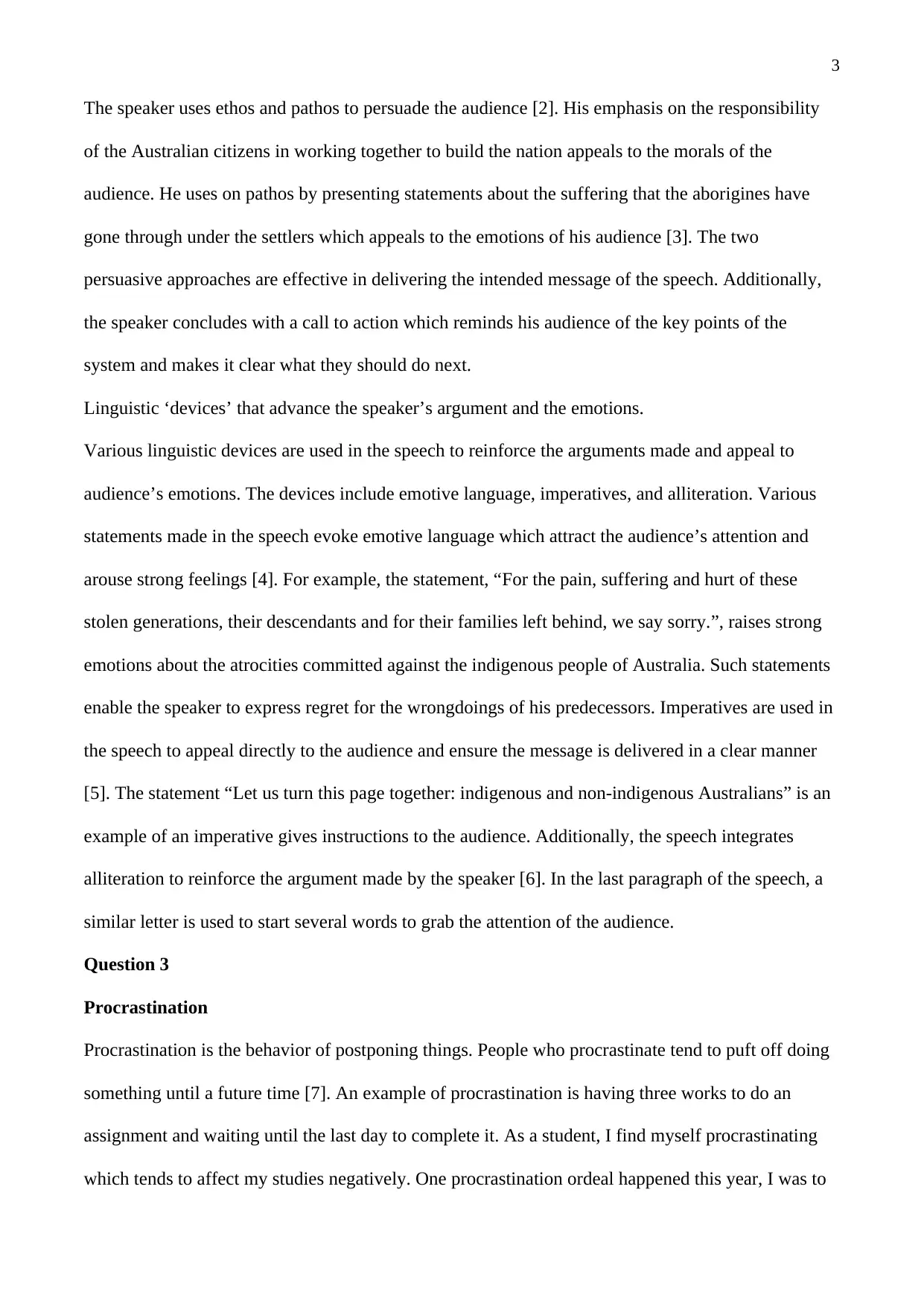
3
The speaker uses ethos and pathos to persuade the audience [2]. His emphasis on the responsibility
of the Australian citizens in working together to build the nation appeals to the morals of the
audience. He uses on pathos by presenting statements about the suffering that the aborigines have
gone through under the settlers which appeals to the emotions of his audience [3]. The two
persuasive approaches are effective in delivering the intended message of the speech. Additionally,
the speaker concludes with a call to action which reminds his audience of the key points of the
system and makes it clear what they should do next.
Linguistic ‘devices’ that advance the speaker’s argument and the emotions.
Various linguistic devices are used in the speech to reinforce the arguments made and appeal to
audience’s emotions. The devices include emotive language, imperatives, and alliteration. Various
statements made in the speech evoke emotive language which attract the audience’s attention and
arouse strong feelings [4]. For example, the statement, “For the pain, suffering and hurt of these
stolen generations, their descendants and for their families left behind, we say sorry.”, raises strong
emotions about the atrocities committed against the indigenous people of Australia. Such statements
enable the speaker to express regret for the wrongdoings of his predecessors. Imperatives are used in
the speech to appeal directly to the audience and ensure the message is delivered in a clear manner
[5]. The statement “Let us turn this page together: indigenous and non-indigenous Australians” is an
example of an imperative gives instructions to the audience. Additionally, the speech integrates
alliteration to reinforce the argument made by the speaker [6]. In the last paragraph of the speech, a
similar letter is used to start several words to grab the attention of the audience.
Question 3
Procrastination
Procrastination is the behavior of postponing things. People who procrastinate tend to puft off doing
something until a future time [7]. An example of procrastination is having three works to do an
assignment and waiting until the last day to complete it. As a student, I find myself procrastinating
which tends to affect my studies negatively. One procrastination ordeal happened this year, I was to
The speaker uses ethos and pathos to persuade the audience [2]. His emphasis on the responsibility
of the Australian citizens in working together to build the nation appeals to the morals of the
audience. He uses on pathos by presenting statements about the suffering that the aborigines have
gone through under the settlers which appeals to the emotions of his audience [3]. The two
persuasive approaches are effective in delivering the intended message of the speech. Additionally,
the speaker concludes with a call to action which reminds his audience of the key points of the
system and makes it clear what they should do next.
Linguistic ‘devices’ that advance the speaker’s argument and the emotions.
Various linguistic devices are used in the speech to reinforce the arguments made and appeal to
audience’s emotions. The devices include emotive language, imperatives, and alliteration. Various
statements made in the speech evoke emotive language which attract the audience’s attention and
arouse strong feelings [4]. For example, the statement, “For the pain, suffering and hurt of these
stolen generations, their descendants and for their families left behind, we say sorry.”, raises strong
emotions about the atrocities committed against the indigenous people of Australia. Such statements
enable the speaker to express regret for the wrongdoings of his predecessors. Imperatives are used in
the speech to appeal directly to the audience and ensure the message is delivered in a clear manner
[5]. The statement “Let us turn this page together: indigenous and non-indigenous Australians” is an
example of an imperative gives instructions to the audience. Additionally, the speech integrates
alliteration to reinforce the argument made by the speaker [6]. In the last paragraph of the speech, a
similar letter is used to start several words to grab the attention of the audience.
Question 3
Procrastination
Procrastination is the behavior of postponing things. People who procrastinate tend to puft off doing
something until a future time [7]. An example of procrastination is having three works to do an
assignment and waiting until the last day to complete it. As a student, I find myself procrastinating
which tends to affect my studies negatively. One procrastination ordeal happened this year, I was to
⊘ This is a preview!⊘
Do you want full access?
Subscribe today to unlock all pages.

Trusted by 1+ million students worldwide
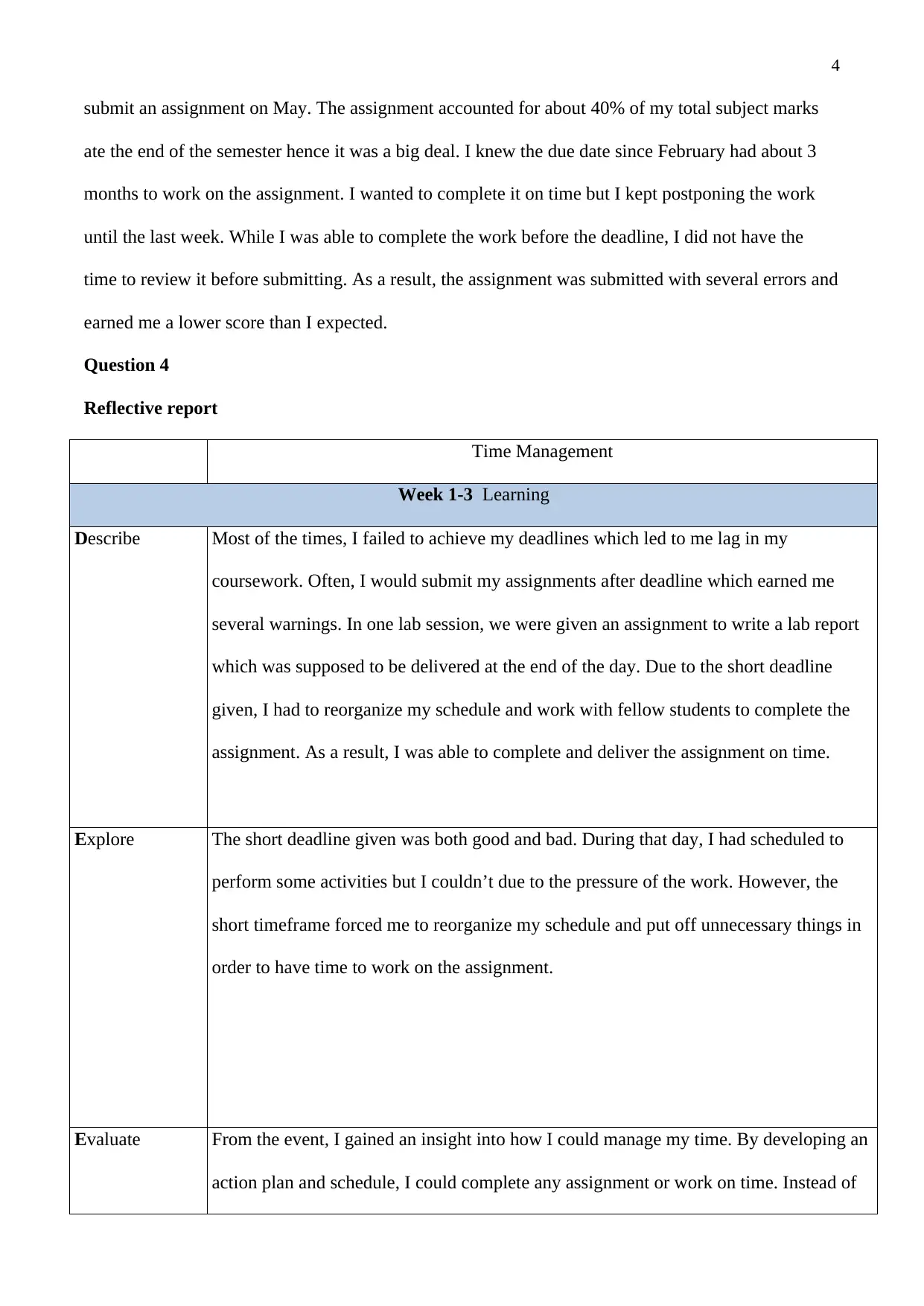
4
submit an assignment on May. The assignment accounted for about 40% of my total subject marks
ate the end of the semester hence it was a big deal. I knew the due date since February had about 3
months to work on the assignment. I wanted to complete it on time but I kept postponing the work
until the last week. While I was able to complete the work before the deadline, I did not have the
time to review it before submitting. As a result, the assignment was submitted with several errors and
earned me a lower score than I expected.
Question 4
Reflective report
Time Management
Week 1-3 Learning
Describe Most of the times, I failed to achieve my deadlines which led to me lag in my
coursework. Often, I would submit my assignments after deadline which earned me
several warnings. In one lab session, we were given an assignment to write a lab report
which was supposed to be delivered at the end of the day. Due to the short deadline
given, I had to reorganize my schedule and work with fellow students to complete the
assignment. As a result, I was able to complete and deliver the assignment on time.
Explore The short deadline given was both good and bad. During that day, I had scheduled to
perform some activities but I couldn’t due to the pressure of the work. However, the
short timeframe forced me to reorganize my schedule and put off unnecessary things in
order to have time to work on the assignment.
Evaluate From the event, I gained an insight into how I could manage my time. By developing an
action plan and schedule, I could complete any assignment or work on time. Instead of
submit an assignment on May. The assignment accounted for about 40% of my total subject marks
ate the end of the semester hence it was a big deal. I knew the due date since February had about 3
months to work on the assignment. I wanted to complete it on time but I kept postponing the work
until the last week. While I was able to complete the work before the deadline, I did not have the
time to review it before submitting. As a result, the assignment was submitted with several errors and
earned me a lower score than I expected.
Question 4
Reflective report
Time Management
Week 1-3 Learning
Describe Most of the times, I failed to achieve my deadlines which led to me lag in my
coursework. Often, I would submit my assignments after deadline which earned me
several warnings. In one lab session, we were given an assignment to write a lab report
which was supposed to be delivered at the end of the day. Due to the short deadline
given, I had to reorganize my schedule and work with fellow students to complete the
assignment. As a result, I was able to complete and deliver the assignment on time.
Explore The short deadline given was both good and bad. During that day, I had scheduled to
perform some activities but I couldn’t due to the pressure of the work. However, the
short timeframe forced me to reorganize my schedule and put off unnecessary things in
order to have time to work on the assignment.
Evaluate From the event, I gained an insight into how I could manage my time. By developing an
action plan and schedule, I could complete any assignment or work on time. Instead of
Paraphrase This Document
Need a fresh take? Get an instant paraphrase of this document with our AI Paraphraser
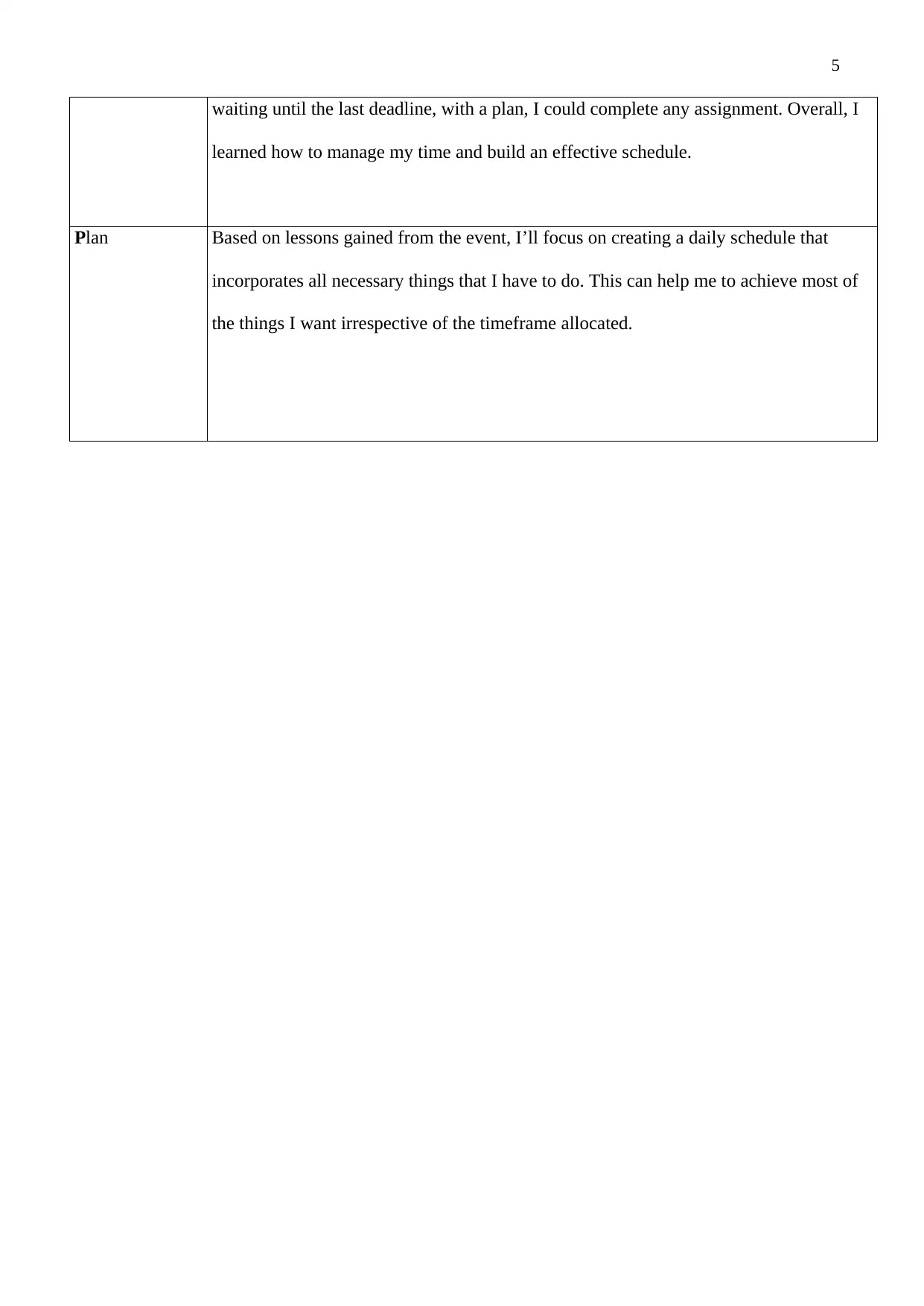
5
waiting until the last deadline, with a plan, I could complete any assignment. Overall, I
learned how to manage my time and build an effective schedule.
Plan Based on lessons gained from the event, I’ll focus on creating a daily schedule that
incorporates all necessary things that I have to do. This can help me to achieve most of
the things I want irrespective of the timeframe allocated.
waiting until the last deadline, with a plan, I could complete any assignment. Overall, I
learned how to manage my time and build an effective schedule.
Plan Based on lessons gained from the event, I’ll focus on creating a daily schedule that
incorporates all necessary things that I have to do. This can help me to achieve most of
the things I want irrespective of the timeframe allocated.
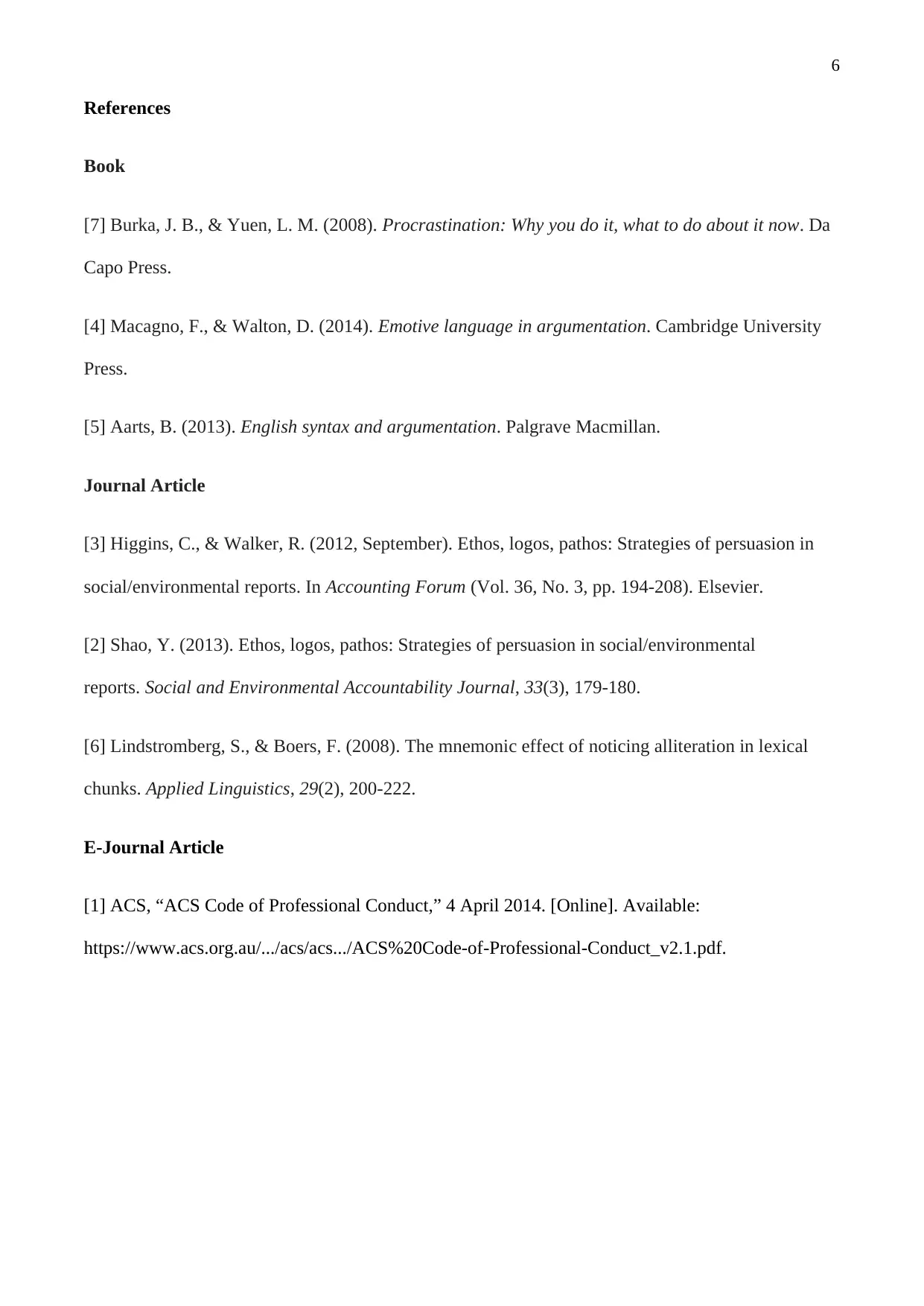
6
References
Book
[7] Burka, J. B., & Yuen, L. M. (2008). Procrastination: Why you do it, what to do about it now. Da
Capo Press.
[4] Macagno, F., & Walton, D. (2014). Emotive language in argumentation. Cambridge University
Press.
[5] Aarts, B. (2013). English syntax and argumentation. Palgrave Macmillan.
Journal Article
[3] Higgins, C., & Walker, R. (2012, September). Ethos, logos, pathos: Strategies of persuasion in
social/environmental reports. In Accounting Forum (Vol. 36, No. 3, pp. 194-208). Elsevier.
[2] Shao, Y. (2013). Ethos, logos, pathos: Strategies of persuasion in social/environmental
reports. Social and Environmental Accountability Journal, 33(3), 179-180.
[6] Lindstromberg, S., & Boers, F. (2008). The mnemonic effect of noticing alliteration in lexical
chunks. Applied Linguistics, 29(2), 200-222.
E-Journal Article
[1] ACS, “ACS Code of Professional Conduct,” 4 April 2014. [Online]. Available:
https://www.acs.org.au/.../acs/acs.../ACS%20Code-of-Professional-Conduct_v2.1.pdf.
References
Book
[7] Burka, J. B., & Yuen, L. M. (2008). Procrastination: Why you do it, what to do about it now. Da
Capo Press.
[4] Macagno, F., & Walton, D. (2014). Emotive language in argumentation. Cambridge University
Press.
[5] Aarts, B. (2013). English syntax and argumentation. Palgrave Macmillan.
Journal Article
[3] Higgins, C., & Walker, R. (2012, September). Ethos, logos, pathos: Strategies of persuasion in
social/environmental reports. In Accounting Forum (Vol. 36, No. 3, pp. 194-208). Elsevier.
[2] Shao, Y. (2013). Ethos, logos, pathos: Strategies of persuasion in social/environmental
reports. Social and Environmental Accountability Journal, 33(3), 179-180.
[6] Lindstromberg, S., & Boers, F. (2008). The mnemonic effect of noticing alliteration in lexical
chunks. Applied Linguistics, 29(2), 200-222.
E-Journal Article
[1] ACS, “ACS Code of Professional Conduct,” 4 April 2014. [Online]. Available:
https://www.acs.org.au/.../acs/acs.../ACS%20Code-of-Professional-Conduct_v2.1.pdf.
⊘ This is a preview!⊘
Do you want full access?
Subscribe today to unlock all pages.

Trusted by 1+ million students worldwide
1 out of 6
Related Documents
Your All-in-One AI-Powered Toolkit for Academic Success.
+13062052269
info@desklib.com
Available 24*7 on WhatsApp / Email
![[object Object]](/_next/static/media/star-bottom.7253800d.svg)
Unlock your academic potential
Copyright © 2020–2025 A2Z Services. All Rights Reserved. Developed and managed by ZUCOL.




